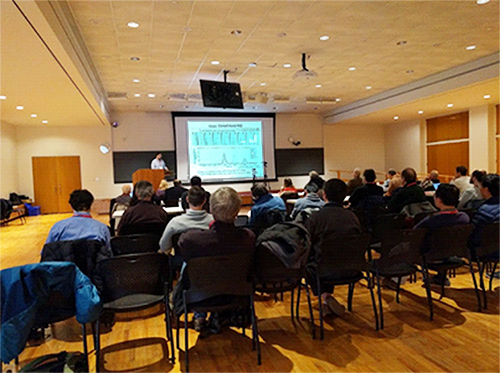X-RAY RUNS: Apply for Beamtime
2017 Nov 1 - Dec 21
2018 Feb 7 - Apr 3
2018 Proposal/BTR deadline: 12/1/17
2018 Apr 11 - Jun 4
2018 Proposal/BTR deadline: 2/1/18
Our users may be aware that during the summer of 2016, CHESS hosted six workshops to help outline a science case for an upgraded single-beam, high-energy source that will result from the current CHESS-U upgrade project. During those workshops, astute scientists like Phil Anfinrud (NIH) prompted CHESS management to explore how our upgraded source might serve scientists needing large x-ray pulses. His questions followed an external review of the accelerator upgrade which also pointed out that the CHESS source – CESR – was flexible enough to support particle beam bunch patterns having high bunch charge (up to 50 nanoCoulombs per bunch) and flexible timing (from 14 to 644 nanoseconds). That review happened after the six science workshops were already organized, so flexible bunch structure was not one of the themes.
Soon after the summer workshops it became clear that CHESS should explore this area, so a seventh workshop was organized to explore how x-ray pulses and a flexible timing bunch structure could create opportunities for new science. The workshop “CHESS-U as a pulsed x-ray source with high-bunch-charge and flexible timing” was held on Thursday, March 9th, 2017 with an expressed mission to explore how custom x-ray pulses might create new capabilities for unique science contributions. See the agenda here. Invited talks covered biological, condensed matter, and structural materials. Speakers included P. Anfinrud (NIH), A. Pearson (Hamburg Centre for Ultrafast Imaging), K. Moffat (U. Chicago), T. C. Hufnagel (Johns Hopkins), J. Lind and J. Bernier (LLNL), B. Jensen (LANL), D. Walko and E. E. Alp (ANL), L. X. Chen (ANL, Northwestern), and J. Shanks and J. Becker (Cornell). There were 33 attendees; 5 of whom were participating remotely.
 Speaker Julian Becker (Cornell) discusses x-ray detector needs and optimizations for fast pulse and high-repetition rate measurements.
Speaker Julian Becker (Cornell) discusses x-ray detector needs and optimizations for fast pulse and high-repetition rate measurements.
The desired output from the workshop was to educate the x-ray and accelerator staff at CHESS about the needs of pulsed-beam experiments and identify technical specifications that would make CHESS-U a valuable scientific tool. We hoped that the needs of these experiments would help shape the performance goals for the accelerator group as well as the x-ray beamline optics design priorities. We were not disappointed on any of our goals. The speakers did an excellent job of showing the challenges to capture fast phenomena with x-rays in their respective science fields. Issues discussed included how to maximize x-ray flux, avoid detector pileup and short beam lifetime, bunch feedback and stability, reaction initiation, synchronization of pulses with detectors and specimen shock, multiplexing optical cameras, among many others. Being experts in both their scientific fields and in using x-rays for these difficult measurements, the topics and solutions discussed helped maintain a high level of interest and active discussions throughout the day.
Once again CHESS wishes to thank all the speakers for an interesting and informative workshop.
 Website masthead graphic showing three types of bunch patterns proposed for the future CHESS-U source.
Website masthead graphic showing three types of bunch patterns proposed for the future CHESS-U source.
Submitted by: Ernest Fontes, CHESS, Cornell University
04/13/2017
